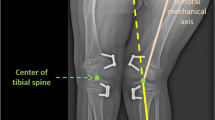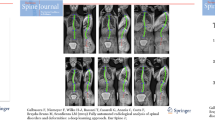Abstract
Manual measurements of migration percentage (MP) on pelvis radiographs for assessing hip displacement are subjective and time consuming. A deep learning approach using convolution neural networks (CNNs) to automatically measure the MP was proposed. The pre-trained Inception ResNet v2 was fine tuned to detect locations of the eight reference landmarks used for MP measurements. A second network, fine-tuned MobileNetV2, was trained on the regions of interest to obtain more precise landmarks’ coordinates. The MP was calculated from the final estimated landmarks’ locations. A total of 122 radiographs were divided into 57 for training, 10 for validation, and 55 for testing. The mean absolute difference (MAD) and intra-class correlation coefficient (ICC [2,1]) of the comparison for the MP on 110 measurements (left and right hips) were 4.5 \(\pm\) 4.3% (95% CI, 3.7–5.3%) and 0.91, respectively. Sensitivity and specificity were 87.8% and 93.4% for the classification of hip displacement (MP-threshold of 30%), and 63.2% and 94.5% for the classification of surgery-needed hips (MP-threshold of 40%). The prediction results were returned within 5 s. The developed fine-tuned CNNs detected the landmarks and provided automatic MP measurements with high accuracy and excellent reliability, which can assist clinicians to diagnose hip displacement in children with CP.
Graphical abstract









Similar content being viewed by others
References
Rosenbaum P, Paneth N, Leviton A et al (2007) A report: the definition and classification of cerebral palsy April 2006. Dev Med Child Neurol Suppl 109:8–14
Cornell MS (1995) The hip in cerebral palsy. Dev Med Child Neurol 37:3–18. https://doi.org/10.1111/j.1469-8749.1995.tb11928.x
Soo B, Howard JJ, Boyd RN et al (2006) Hip displacement in cerebral palsy. J Bone Joint Surg 88:121–129. https://doi.org/10.2106/JBJS.E.00071
Hägglund G, Lauge-Pedersen H, Wagner P (2007) Characteristics of children with hip displacement in cerebral palsy. BMC Musculoskelet Disord. https://doi.org/10.1186/1471-2474-8-101
Bagg MR, Farber J, Miller F (1993) Long-term follow-up of hip subluxation in cerebral palsy patients. J Pediatr Orthop 13:32–36
Jung NH, Pereira B, Nehring I et al (2014) Does hip displacement influence health-related quality of life in children with cerebral palsy? Dev Neurorehabil 17:420–425. https://doi.org/10.3109/17518423.2014.941116
Wynter M, Gibson N, Willoughby KL (2015) Australian hip surveillance guidelines for children with cerebral palsy: 5-year review. Dev Med Child Neurol 57:808–820. https://doi.org/10.1111/dmcn.12754
Dobson F, Boyd RN, Parrott J et al (2002) Hip surveillance in children with cerebral palsy: impact on the surgical management of spastic hip disease. J Bone Joint Surg Br 84:720–726. https://doi.org/10.1302/0301-620X.84B5.0840720
Hägglund G, Alriksson-Schmidt A, Lauge-Pedersen H et al (2014) Prevention of dislocation of the hip in children with cerebral palsy: 20-year results of a population-based prevention programme. Bone Joint J 96:1546–1552. https://doi.org/10.1302/0301-620X.96B11.34385
Elkamil AI, Andersen GL, Hägglund G et al (2011) Prevalence of hip dislocation among children with cerebral palsy in regions with and without a surveillance programme: a cross sectional study in Sweden and Norway. BMC Musculoskelet Disord 12:284
Reimers J (1980) The stability of the hip in children: a radiological study of the results of muscle surgery in cerebral palsy. Acta Orthop Scand 51:1–100
Shore BJ, Martinkevich P, Riazi M et al (2019) Reliability of radiographic assessments of the hip in cerebral palsy. J Pediatr Orthop 39:e536-541. https://doi.org/10.1097/BPO.0000000000001318
Parrott J, Boyd RN, Dobson F et al (2002) Hip displacement in spastic cerebral palsy: repeatability of radiologic measurement. J Pediatr Orthop 22:660–667
Pons C, Rémy-Néris O, Médée B et al (2013) Validity and reliability of radiological methods to assess proximal hip geometry in children with cerebral palsy: a systematic review. Dev Med Child Neurol 55:1089–1102. https://doi.org/10.1111/dmcn.12169
Craven A, Pym A, Boyd RN (2014) Reliability of radiologic measures of hip displacement in a cohort of preschool-aged children with cerebral palsy. J Pediatr Orthop 34:597–602. https://doi.org/10.1097/BPO.0000000000000227
Faraj S, Atherton WG, Stott NS (2004) Inter-and intra-measurer error in the measurement of Reimers’ hip migration percentage”. J Bone Joint Surg Br 86:434–437. https://doi.org/10.1302/0301-620X.86B3.14094
Robin J, Graham HK, Baker R et al (2009) A classification system for hip disease in cerebral palsy. Dev Med Child Neurol 51:183–192. https://doi.org/10.1111/j.1469-8749.2008.03129.x
Kulkarni VA, Davids JR, Boyles AD et al (2018) Reliability and efficiency of three methods of calculating migration percentage on radiographs for hip surveillance in children with cerebral palsy. J Child Orthop 12:145–151. https://doi.org/10.1302/1863-2548.12.170189
Litjens G, Kooi T, Bejnordi BE et al (2017) A survey on deep learning in medical image analysis. Med Image Anal 42:60–88. https://doi.org/10.1016/j.media.2017.07.005
Golan D, Donner Y, Mansi C et al (2016) Fully automating Graf’s method for DDH diagnosis using deep convolutional neural networks. Deep Learning and Data Labeling for Medical Applications. Springer, Cham, pp 130–141
Hareendranathan AR, Zonoobi D, Mabee M et al (2017) Toward automatic diagnosis of hip dysplasia from 2D ultrasound. in IEEE 14th International Symposium on Biomedical Imaging (ISBI 2017), pp. 982–985.
Zhang Z, Tang M, Cobzas D et al (2018) End-to-end detection-segmentation network with ROI convolution, in IEEE 15th International Symposium on Biomedical Imaging (ISBI 2018), pp. 1509–1512.
Paserin O, Mulpuri K, Cooper A et al (2018) Real time RNN based 3D ultrasound scan adequacy for developmental dysplasia of the hip. International Conference on Medical Image Computing and Computer-Assisted Intervention. Springer, Cham, pp 365–373
Chee CG, Kim Y, Kang Y et al (2019) Performance of a deep learning algorithm in detecting osteonecrosis of the femoral head on digital radiography: a comparison with assessments by radiologists. Am J Roentgenol 213:155–162. https://doi.org/10.2214/AJR.18.20817
Gale W, Oakden-Rayner L, Carneiro G (2017) Detecting hip fractures with radiologist-level performance using deep neural networks. https://arxiv.org/abs/1711.06504. Accessed 17 Nov 2017
Adams M, Chen W, Holcdorf D et al (2019) Computer vs human: deep learning versus perceptual training for the detection of neck of femur fractures. J Med Imag Radiat On 63:27–32. https://doi.org/10.1111/1754-9485.12828
Urakawa T, Tanaka Y, Goto S et al (2019) Detecting intertrochanteric hip fractures with orthopedist-level accuracy using a deep convolutional neural network. Skeletal Radiol 48:239–244. https://doi.org/10.1007/s00256-018-3016-3
Kazi A, Albarqouni S, Sanchez AJ et al (2017) Automatic classification of proximal femur fractures based on attention models. International Workshop on Machine Learning in Medical Imaging. Springer, Cham, pp 70–78
Xue Y, Zhang R, Deng Y et al (2017) A preliminary examination of the diagnostic value of deep learning in hip osteoarthritis. PLoS ONE 12:e0178992. https://doi.org/10.1371/journal.pone.0178992
Liu C, Xie H, Zhang S et al (2020) Misshapen pelvis landmark detection with local-global feature learning for diagnosing developmental dysplasia of the hip. IEEE Transactions Med Imag 39:3944–3954. https://doi.org/10.1109/TMI.2020.3008382
Li Q, Zhong L, Huang H et al (2019) Auxiliary diagnosis of developmental dysplasia of the hip by automated detection of Sharp’s angle on standardized anteroposterior pelvic radiographs. Med 98https://doi.org/10.1097/MD.0000000000018500.
Liu W, Wang Y, Jiang T et al (2020) Landmarks detection with anatomical constraints for total hip arthroplasty preoperative measurements. International Conference on Medical Image Computing and Computer-Assisted Intervention. Springer, Cham, pp 670–679
Yang W, Ye Q, Ming S et al (2020) Feasibility of automatic measurements of hip joints based on pelvic radiography and a deep learning algorithm. Eur J Radiol 132:109303. https://doi.org/10.1016/j.ejrad.2020.109303
Schlegl T, Ofner J, Langs G (2014) Unsupervised pre-training across image domains improves lung tissue classification. International MICCAI Workshop on Medical Computer Vision. Springer, Cham, pp 82–93
Tajbakhsh N, Shin JY, Gurudu SR et al (2016) Convolutional neural networks for medical image analysis: full training or fine tuning? IEEE Trans Med Imag 35:1299–1312. https://doi.org/10.1109/TMI.2016.2535302
Shie CK, Chuang CH, Chou CN et al (2015) Transfer representation learning for medical image analysis, in 37th annual international conference of the IEEE Engineering in Medicine and Biology Society (EMBC 2015), pp. 711–714.
Shin HC, Roth HR, Gao M et al (2016) Deep convolutional neural networks for computer-aided detection: CNN architectures, dataset characteristics and transfer learning. IEEE Transactions Med Imag 35:1285–1298. https://doi.org/10.1109/TMI.2016.2528162
Ahmed KB, Hall LO, Goldgof DB et al (2017) Fine-tuning convolutional deep features for MRI based brain tumor classification, in Medical Imaging 2017: computer-aided diagnosis, International Society for Optics and Photonics, 10134:101342E.
Kieffer B, Babaie M, Kalra S et al (2017) Convolutional neural networks for histopathology image classification: Training vs. using pre-trained networks, in IEEE Seventh International Conference on Image Processing Theory, Tools and Applications (IPTA 2017), pp. 1–6.
Ferreira CA, Melo T, Sousa P et al (2018) Classification of breast cancer histology images through transfer learning using a pre-trained inception resnet v2, in International Conference Image Analysis and Recognition 2018, pp. 763–770.
Liu X, Wang C, Bai J et al (2020) Fine-tuning pre-trained convolutional neural networks for gastric precancerous disease classification on magnification narrow-band imaging images. Neurocomputing 392:253–267. https://doi.org/10.1016/j.neucom.2018.10.100
Jiang Z, Zhang H, Wang Y et al (2018) Retinal blood vessel segmentation using fully convolutional network with transfer learning. Comput Med Imag Grap 68:1–5. https://doi.org/10.1016/j.compmedimag.2018.04.005
Mishra D, Chaudhury S, Sarkar M et al (2018) Ultrasound image segmentation: a deeply supervised network with attention to boundaries. IEEE Trans Biomed Eng 66:1637–1648. https://doi.org/10.1109/TBME.2018.2877577
Deng G (2010) A generalized unsharp masking algorithm. IEEE Trans Image Process 20:1249–1261. https://doi.org/10.1109/TIP.2010.2092441
Chen X, Huang L, Chen Y (2019) Facial Landmark Detection based on Cascade Neural network, in Journal of Physics: Conference Series 1237:032048, IOP Publishing.
Lv J, Shao X, Xing J et al (2017) A deep regression architecture with two-stage re-initialization for high performance facial landmark detection, in Proceedings of the IEEE conference on computer vision and pattern recognition 2017, pp. 3317–3326.
Szegedy C, Ioffe S, Vanhoucke V et al (2017) Inception-v4, inception-resnet and the impact of residual connections on learning, in Proceedings of the AAAI Conference on Artificial Intelligence 2017, v.31.
He K, Zhang X, Ren S et al (2016) Deep residual learning for image recognition, in Proceedings of the IEEE conference on computer vision and pattern recognition, pp. 770–778.
Szegedy C, Liu W, Jia Y et al (2015) Going deeper with convolutions, in Proceedings of the IEEE conference on computer vision and pattern recognition 2015, pp. 1–9.
Szegedy C, Vanhoucke V, Ioffe S et al (2016) Rethinking the inception architecture for computer vision. InProceedings of the IEEE conference on computer vision and pattern recognition 2016, pp. 2818-2826.
Huang G, Liu Z, Van Der Maaten L et al (2017) Densely connected convolutional networks,” in Proceedings of the IEEE conference on computer vision and pattern recognition 2017, pp. 4700–4708.
Zoph B, Le QV (2016) Neural architecture search with reinforcement learning. https://arxiv.org/abs/1611.01578. Accessed 5 Nov 2016
Liu C, Zoph B, Neumann M et al (2018) Progressive neural architecture search,” Proceedings of the European Conference on Computer Vision (ECCV 2018), pp. 19–34.
Sandler M, Howard A, Zhu M et al (2018) Mobilenetv2: inverted residuals and linear bottlenecks, in Proceedings of the IEEE conference on computer vision and pattern recognition 2018, pp. 4510–4520.
Howard AG, Zhu M, Chen B et al (2017) Mobilenets: efficient convolutional neural networks for mobile vision applications. https://arxiv.org/abs/1704.04861. Accessed 17 Apr 2017
Kingma DP, Ba J. Adam (2014) Adam: a method for stochastic optimization. https://arxiv.org/abs/1412.6980. Accessed 22 Dec 2014
Gupta S, Mazumdar SG (2013) Sobel edge detection algorithm. Int J Comput Sci Manag Res 2:1578–1583
Shore BJ, Shrader MW, Narayanan U et al (2017) Hip surveillance for children with cerebral palsy: a survey of the POSNA membership. J Pediatr Orthop 37:e409–e414. https://doi.org/10.1097/BPO.0000000000001050
Cliffe L, Sharkey D, Charlesworth G (2011) Correct positioning for hip radiographs allows reliable measurement of hip displacement in cerebral palsy. Dev Med Child Neu 53:549–552
Kim SM, Sim EG, Lim SG et al (2012) Reliability of hip migration index in children with cerebral palsy: the classic and modified methods. Ann Rehabil Med 36:33. https://doi.org/10.5535/arm.2012.36.1.33
Watson PF, Petrie A (2010) Method agreement analysis: a review of correct methodology. Theriogenology 73:1167–1179. https://doi.org/10.1016/j.theriogenology.2010.01.003
Author information
Authors and Affiliations
Corresponding author
Ethics declarations
Conflict of interest
The authors declare no competing interests.
Additional information
Publisher's note
Springer Nature remains neutral with regard to jurisdictional claims in published maps and institutional affiliations.
Rights and permissions
About this article
Cite this article
Pham, TT., Le, MB., Le, L.H. et al. Assessment of hip displacement in children with cerebral palsy using machine learning approach. Med Biol Eng Comput 59, 1877–1887 (2021). https://doi.org/10.1007/s11517-021-02416-9
Received:
Accepted:
Published:
Issue Date:
DOI: https://doi.org/10.1007/s11517-021-02416-9




